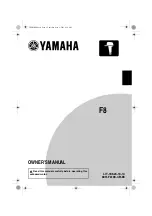
dS28
dS28
32
32
User Manual v4.10
The UID buttons will have the UID’s found, listed in ascending order (not the physical position
on the bus). If you need to identify which module assigned to that UID, click the button and all
LEDs on the module will flash. Only one module will be in identify mode at any time. If you
click another button, then that modules LEDs will flash and the first module will stop. Click the
button again, or click an empty (0) button to stop the flashing and clear identify mode.
Note that normal operation of the dSx modules is inhibited in identify mode.
Mapping the dSx modules.
Each dSx module has 2 outputs and 4 inputs. The 2 relays may be mapped onto any of the 32
relays (real or virtual). Mapping a module to position 5 means that relays 1 and 2 on the dSx
module will be controlled by virtual relays 5 and 6 on the dS2832. The mapping can be
changed by selecting a new mapping with the drop-down box.
dSx Mapping
Table
Mapping Relay 1
Relay 2
Input 2
Input 2
Input 3
Input 4
1
1
2
100*
101*
102
103
3
3
4
104
105
106
107
5
5
6
108
109
110
111
7
7
8
112
113
114
115
9
9
10
116
117
118
119
11
11
12
120
121
122
123
13
13
14
124
125
126
127
15
15
16
128
129
130
131
17
17
18
132
133
134
135
19
19
20
136
137
138
139
21
21
22
140
141
142
143
23
23
24
144
145
146
147
25
25
26
148
149
150
151
27
27
28
152
153
154
155
29
29
30
156
157
158
159
31
31
32
160
161
162
163
* Note that inputs 100 and 101 are not available, either as analogue or digital inputs. If you
need to use all inputs on the dSx module, map it something other than 1.
This is because A100 and A101 are historically used for the on-board temperature and DC volt-
age inputs.
Copyright
© 2016-2022,
Devantech Ltd.
All rights reserved.
23















































